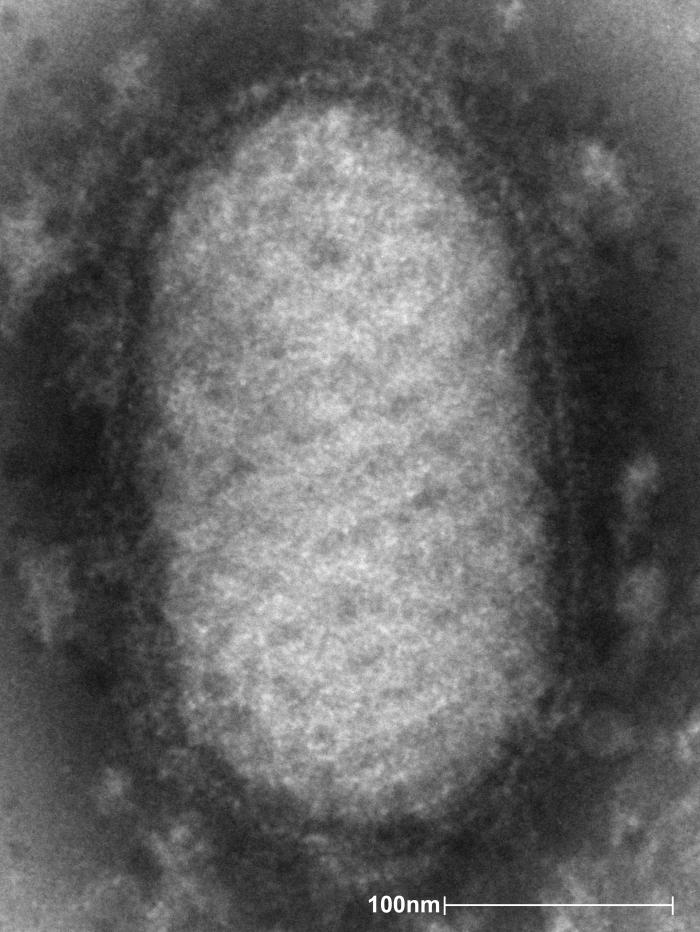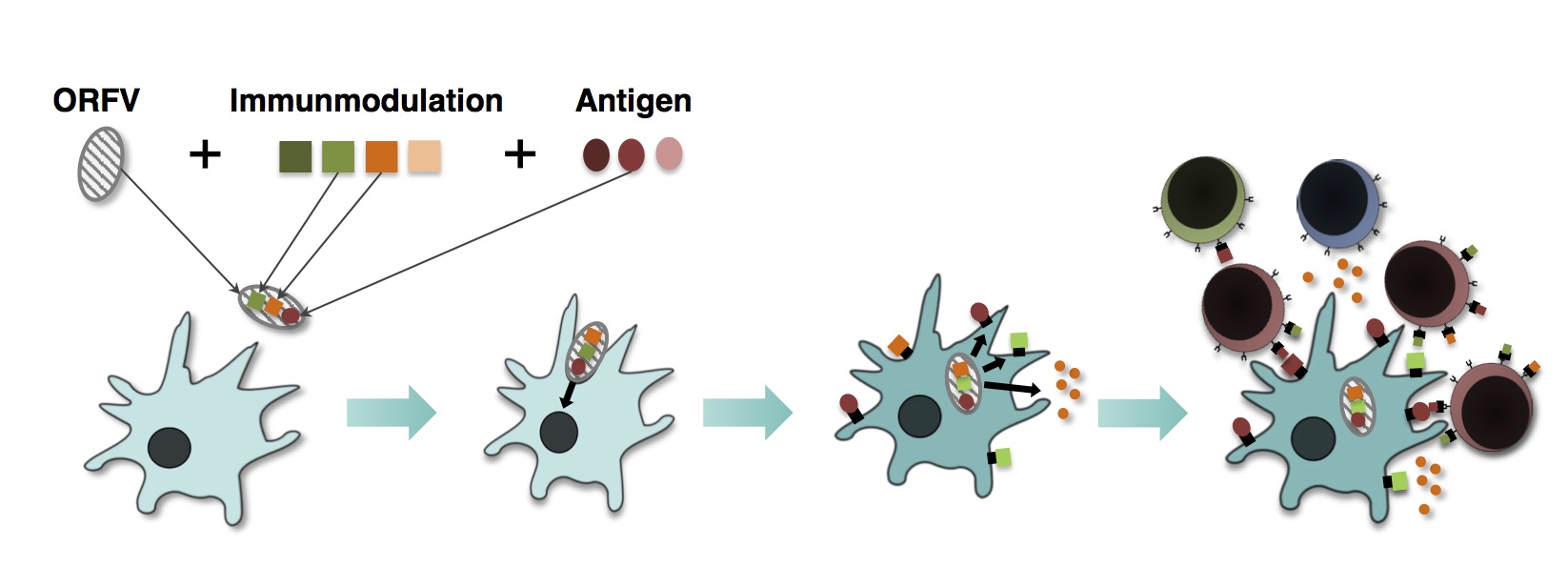Prime Vector Technologies GmbH
A modular brick system for developing a COVID-19 vaccine
Prime Vector Technologies GmbH (PVT), a start-up company based in Tübingen in southern Germany, uses a modular brick system to develop vaccines against cancer and infectious diseases. The PVT team is currently working flat out to develop a COVID-19 vaccine.
 Electron microscope image of ORFV (Orf virus). The virus is around 220 to 300 nm long and 140 to 170 nm wide. Photo: Cynthia Goldsmith, source: CDC's Public Health Image Library Image #8434
Electron microscope image of ORFV (Orf virus). The virus is around 220 to 300 nm long and 140 to 170 nm wide. Photo: Cynthia Goldsmith, source: CDC's Public Health Image Library Image #8434In late March, Prime Vector Technologies GmbH (PVT) made the decision to develop a vaccine against COVID-19. Things then started moving fairly quickly: an application letter was sent to the Project Management Jülich (PtJ) agency (editor’s note: PtJ works on behalf of the following German ministries: Education and Research (BMBF), Economic Affairs and Energy (BMWi), the Environment, Nature Conservation, Building and Nuclear Safety (BMU), and Transport and Digital Infrastructure (BMVI)). The BMWi then requested a project draft, the project description was subsequently submitted, examined by the BMWi, and just a few days later, PVT received a BMWi grant of 1.33 million euros and the project got underway.
PVT was founded in Tübingen in October 2019 and develops vaccines against infectious diseases and cancer in close cooperation with the Department of Immunology at the University Hospital of Tübingen. What distinguishes the company’s concept from that of many of the organisations competing to develop a COVID-19 vaccine is the modular brick system PVT uses to produce vaccines. The company’s vaccines are based on a special viral vector, Parapoxvirus ovis, also known as Orf virus (ORFV), which has a modular design that makes it possible to develop individualised vector vaccines.
Dr. Ralf Amann, CEO of the company and head of a group of researchers in the Department of Immunology at Tübingen University Hospital, comments: "The advantage of the Orf virus is that it has a large genome which can accommodate the genetic information of tumour- or pathogen-specific antigens. The virus has been attenuated, i.e. weakened in order to make it suitable as a vaccine vector. It can therefore be used as a shuttle for the planned vaccine."
ORFV vaccine vectors have a broad field of application, including prophylactic and therapeutic vaccines for humans and for use in the veterinary sector.
PVT is currently working on the development of therapeutic cancer vaccines - and now also on a COVID-19 vaccine.
A COVID-19 vaccine – assembled according to the modular brick principle
Exactly as it has done in previous projects, the PVT team uses a proprietary platform technology for the production of vaccine elements for the COVID-19 vaccine:
- First, the COVID-19 antigens are identified so that their genetic information can be inserted into the vector. The PVT scientists use current data from scientific literature.
- The DNA fragments that encode the selected coronavirus antigens are then produced (synthesised) in sufficient quantities.
- In addition to antigen-coding elements, further co-stimulatory components are integrated into the vector, including, for example, cytokines that mount an effective immune response.
- The vaccine thus assembled stimulates the antigen-presenting cells (APC) of the immune system. These cells express the encoded elements (antigens and co-stimulatory molecules). This leads to the presentation of the coronavirus antigens on the surface of the cells, and the activation of the immune system.
- This leads to an antigen-specific induction of T cells and B cells and the activation of NK cells (natural killer cells) in the immune system of the vaccinated person. Activated B cells form antibodies against the antigens used and thus initiate the humoral immune response.
 Modular brick principle for producing recombinant vectors according to customer requirements. 1) The customer selects individual modules from the modular brick system and assembles the vaccine vector as desired and required. 2) The desired vector is inoculated and taken up by antigen-presenting cells (APCs). 3) Expression of the elements introduced and modulation of the APCs as required. 4) Activation of immune cells by activated APCs and presentation of the ORFV-encoded antigens. © PVT
Modular brick principle for producing recombinant vectors according to customer requirements. 1) The customer selects individual modules from the modular brick system and assembles the vaccine vector as desired and required. 2) The desired vector is inoculated and taken up by antigen-presenting cells (APCs). 3) Expression of the elements introduced and modulation of the APCs as required. 4) Activation of immune cells by activated APCs and presentation of the ORFV-encoded antigens. © PVT"What is special about this technology is the strong immune response that we can elicit by combining several different antigens and other immunostimulatory elements in our polyvalent vaccine - both at the cellular and humoral immune response level*," explains Melanie Müller, the scientific director at PVT. "The procedure elicits stronger immune responses than methods based on inactivated vaccines - and also stronger immune responses than RNA-, MVA- (modified vaccinia virus Ankara) or VSV- (vesicular stomatitis virus) based vaccines. We have been able to show this in benchmark immunisation studies conducted externally."
Cooperation partners wanted for clinical development
Thanks to the special selection system on which PVT’s platform technology is based, developing vaccines does not take very long. On average, a first vaccine prototype is available within around four working weeks. The PVT team assumes that it will take around the same time to develop a prototype of the COVID-19 vaccine. This will then be followed by preclinical studies in animal models, first in mice, and later in primates.
The vaccine can only be tested in human clinical trials once all of these studies have been successful. This takes about six months. PVT is currently looking for cooperation partners for this phase. "Our company specialises in the preclinical development of viral vaccines," says Dr. Ferdinand Salomon. "We rely on partners to be able to carry out the clinical phase as planned."
Investors or companies interested in working with PVT are asked to contact the company at the address shown on the right.